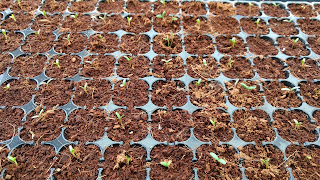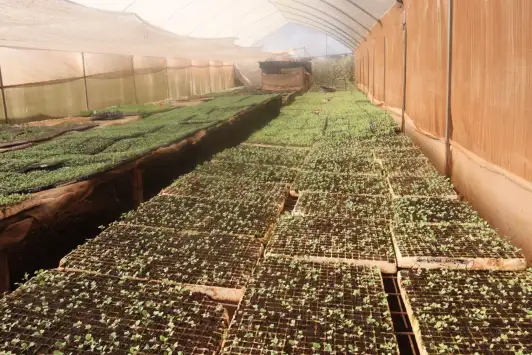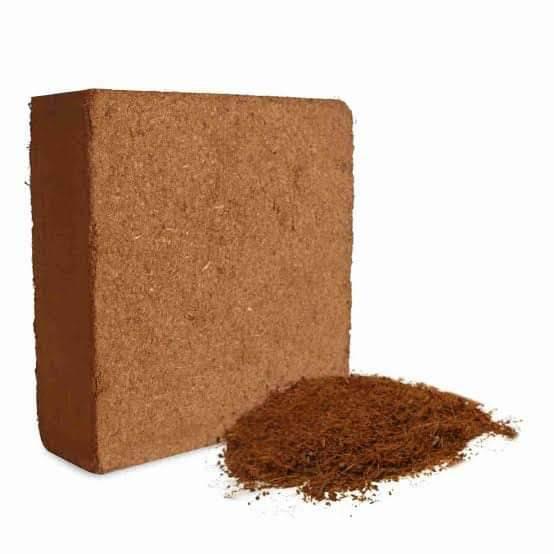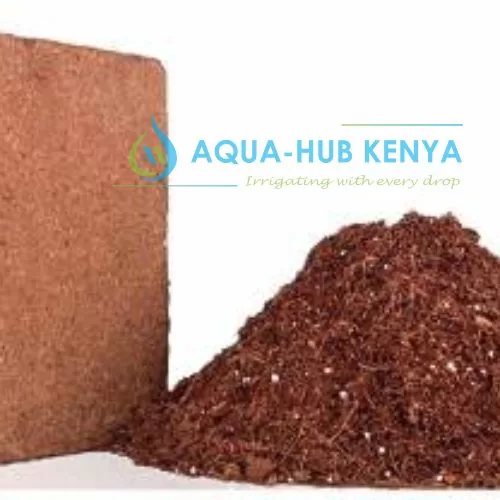Blog
Cocopeat for Seedling Germination | best grow media

Cocopeat for seedling germination is available locally at Aqua Hub Ltd, don’t worry about the delays and high cost of importing the product. Always ensure that cocopeat is treated before you use it to prevent leaching your seedlings.
Cocopeat is sold in blocks weighing 5kg at KES 750 to a maximum of KES 800 each. This price applies for treated cocopeat. Untreated or raw cocopeat is cheaper but contains salts and impurities which affect seedlings
Call 0790719020
Seedling Propagation with Cocopeat

Seedlings germinated in a tray using cocopeat
When you want to raise seedlings whether vegetables, flowers or fruits, you need a medium that gives roots a comfortable start. That’s where Cocopeat comes in. Instead of throwing seeds into ordinary soil and hoping for the best, you give them an optimal growing medium with enough moisture, air, minimal competition. With cocopeat you create that kind of space.
Using cocopeat makes it easier to grow viable seedlings. You’ll get better germination rates, fewer losses, and healthier seedlings ready for your farm or garden.
What is Cocopeat?
Cocopeat is the fibrous material left after coconut husks are processed. The outer husk of a coconut is rich in fibre. When that fibre is removed the leftover dust is processed into cocopeat. It’s also called coir pith or coconut coir dust.
How Cocopeat is Extracted
In simple terms, growers extract the coconut fibre; what remains is washed, compressed into bricks or blocks, dried, and sold as cocopeat.
Properties of Cocopeat for Seedling Germination
When you add water, it expands and becomes a usable medium.
It’s organic, renewable, lightweight, and inert so you can control what you add.
Because it comes from coconut husks, it’s often cleaner than “earth” soil, and it avoids many of the issues of heavy soils (poor drainage, compaction).
It also helps reduce expansion of peat moss, so it has environmental appeal.
Key Benefits of Cocopeat in Seedling Propagation
Cocopeat has several benefits. Here are some of the main ones:
- Excellent water retention: Cocopeat holds water well but also drains reasonably. That means the seedling roots have access to moisture without being drowned.
- Good aeration and root growth: The structure of cocopeat allows air to reach the roots, which stimulates root branching and healthy seedling development.
- Low or manageable salt content (if processed well): Raw cocopeat may have salts leftover from coconut husk processing or local water. But processed cocopeat is washed and treated to make it safe for sensitive seedlings.
- Uniform medium and clean environment: Since cocopeat is manufactured and packaged, you avoid challenges you find in garden soil such as rocks, pathogens and tree roots. That helps for uniform germination.
- Lightweight and easy to manage: For propagation trays, moving pots, cleaning up is easier than heavy soil.
- Reusable potential: Some types of cocopeat can be reused or refreshed for multiple batches of seedlings, reducing waste.
- Sustainable source: Given that it comes from coconut husks, which are a by-product, using cocopeat supports recycling and value-addition in agriculture.
Application of Cocopeat for Seedling Germination
Coco peat is not just for seedlings. It has wide range of uses in crop production. Here are some of the key uses in your garden:
- Seedling propagation: filling seed trays, small pots, raising nursery plants for transplanting.
- Potting mixes: mixing with soil, compost or other media for container plants.
- Hydroponics / soilless systems: cocopeat gives a base medium in systems where you supply nutrients.
- Greenhouse production: for flowers, vegetables and high value crops where you want consistency.
- Soil conditioning: mixing it into heavy or degraded soils to improve structure, aeration, drainage.
- Tree nurseries: for tree seedlings in forestry or agroforestry, cocopeat offers good root establishment.
- Other uses: Because of its absorbent quality, it’s even used as a substrate in vermiculture (worm farming), or absorbent mats.
Cocopeat for Sale in Kenya
Quality cocopeat is available at KES 750 – 800 per 5kg blocks at Aqua Hub LTD. We deal with treated and tested cocopeat recommended for seedling germination.
How to Prepare and Use Cocopeat

Process of seedling germination in trays using cocopeat
Here’s how you can prepare and use cocopeat well to ensure effective seedling cultivation.
Preparation
- If you have a compressed block, immerse it in water so it expands. For example, one block might expand into many litres of loose material once hydrated.
- If the cocopeat is raw/unwashed, soak it and then rinse to reduce salts. For example, some growers soak in a solution of calcium nitrate to replace sodium and potassium salts, then flush with fresh water.
- Let the cocopeat drain excess water so that it is moist but not water-logged. You don’t want seedlings sitting in soggy media.
- Check that pH is within the required rate, around 5.5-6.8 is ideal.
Steps for Usage in Seedling Starting
- Fill seedling trays or small pots with the prepared cocopeat. Lightly press down to remove large air pockets but do not compact the medium too much.
- Sow your seeds: place one or a few seeds per cell/tray, following seed spacing guidelines. Cover lightly depending on the seed type.
- Water gently: but keep the medium moist. Cocopeat will hold moisture, so you may need less frequent watering than bare soil.
- Provide light and warmth as required by your seed type. Good germination needs consistent moisture, proper temperature and light.
- When seedlings have developed true leaves and a good root system, you can transplant them into larger pots or into your field/bed. At transplanting, you may mix cocopeat with soil for smoother adjustment. For example, you might use cocopeat, compost and soil in a ratio like 30:40:30 depending on soil fertility.
- After transplanting, monitor watering: cocopeat retains moisture well, but once outdoors field conditions apply you may need to adapt.
Mixing Tips
- If your soil is heavy/clay you might mix in, say, 20-30% cocopeat to improve drainage.
- If you are doing container or bench-growth, you can use 100% cocopeat and supply nutrients yourself (because cocopeat itself has low nutrient content).
Cocopeat Maintenance
- Keep cocopeat trays covered or in a well-ventilated area so that pests or disease don’t get in.
- Avoid re-using cocopeat without sterilizing or flushing first; you may observe buildup of salt or pathogens after many cycles.
Cost of Cocopeat for Seedling Germination in Kenya
1 kg block is KES 150.
5 kg blocks of cocopeat cost KES 800 each.
Tips for Better Seedling Germination Using Cocopeat
Here are some practical tips you can follow to get the best results:
- Always buy good quality cocopeat – low in debris, well-buffered (low salt), consistent texture.
- If you have untreated cocopeat, don’t skip the soaking and washing step. Salt build-up will hurt seedlings.
- Maintain moisture – cocopeat holds water, but when dry germination will stop. Excess moist conditions raise risk of damping-off or root rot.
- Use trays or pots with drainage holes – cocopeat drains, but excess water should still escape.
- For sowing, keep seeds at optimal depth for that species – cocopeat doesn’t mean you bury deeper.
- Provide adequate but not excessive fertiliser once true leaves appear, since cocopeat doesn’t supply major nutrients by itself.
- Avoid extreme heat or direct harsh sun for seedlings in cocopeat; they still need gentle start conditions.
- Clean trays and media between batches if you re-use cocopeat—disease pressure builds up.
- Label your trays with species and date—propagation in cocopeat tends to be uniform and fast, so you’ll appreciate the tracking.
- After transplanting, gradually acclimatise seedlings to outside conditions if they were started indoors or in shade.
- Ensure you ventilate your nursery or propagation structure; humidity and air movement help prevent fungus.
- If you’re growing at scale, inspect your cocopeat batch for uniformity—some cheaper batches may have clumps or fibre strands that reduce uniform germination.
Start Sustainable Seedling Propagation with Cocopeat
By choosing cocopeat you’re adopting a more sustainable propagation approach. Here’s how you turn it into a routine for your farm or nursery:
- Source local cocopeat so you reduce transport emissions and cost.
- Standardise your propagation media (cocopeat, trays, watering schedule) to get consistent results each season.
- Monitor your seedling survival and growth over time you’ll see lower losses and stronger plants, which means less waste.
- Re-use quality cocopeat where possible: after a batch, you can remove root debris, flush and reuse the medium. That reduces your cost per batch.
- Integrate cocopeat into your mix for transplanting beds,g., use cocopeat, local compost and soil to raise seedlings strong and ready to go.
- Train your team or family members on the care routines (moisture monitoring, hygiene, tray cleaning) so that propagation becomes efficient.
- Track your costs and yields: calculate how many seedlings you get per block of cocopeat, survival rate to transplant, time to transplant stage. Over seasons you’ll refine your process.
- Consider the impact: fewer losses lead to more seedling survival and in turn high yield potential. This means your use of cocopeat helps drive sustainable productivity.
Case Study from a Client in Kenya Using Cocopeat for Vegetable Seedling Germination
Case Study Story for Gracerock Farm, a Seedling Grower in Limuru

Vegetable seedlings propagated in trays using cocopeat at Gracerock Farms Limuru
Gracerock Farm is a seedling vendor based in Limuru, Nairobi County. They propagate wide range of vegetable seedlings including kales, spinach, lettuce, capsicum, tomato, and cabbage. Their seedlings are grown in propagation trays and cocopeat is the primary medium.
They are widely known for propagation of 100 percent viable and healthy seedlings.
Case Study for A Vegetable Grower in Kiambu County
Mary, a small-holder vegetable grower in Kiambu County. She used cocopeat for her tomato seedling propagation this season. Here’s what she did and what she got:
Scenario:
Mary was tired of uneven germination, many seedlings wilting, and transplant shock when she moved seedlings into her field. She switched to cocopeat for her next batch of tomato and pepper seedlings.
What she did:
- She bought 5 kg block of treated cocopeat from our shop.
- She hydrated the block in clean water; let it expand and drained excess water overnight.
- She filled seedling trays (each tray had 50 cells), sowed both tomato and pepper seeds (one seed per cell).
- She kept them in a shade-net house, watered lightly twice daily, monitored moisture, used gentle ventilation.
- After 3 weeks she transplanted seedlings into 1-litre pots with a mix of cocopeat + compost + local loam soil (40:30:30 ratio).
- After another week she moved the plants into her field.
Results:
- Germination rate went from ~70% (in her previous soil-based trays) to ~90% with the cocopeat trays.
- Seedling growth was more uniform: same height, fewer weaklings.
- Transplant shock reduced: fewer seedlings died after transplanting.
- Because seedlings were stronger, she planted in her field slightly earlier (by about 5 days) than usual.
- She estimates that the additional cost of cocopeat paid off by giving her about 10% more plants surviving, which in turn increased her harvest by about 12% for that batch.
- She intends to reuse part of the cocopeat (after cleaning trays) for her next batch, reducing next-time cost.
Key Takeaways
- Switching to cocopeat improved germination and uniformity.
- Strong seedlings matter they cost you less in losses, less labour in weeding out weaklings, and more predictable transplanting.
- Even a small increase in survival can shift your bottom line.
- Re-use idea works: the more you use, the quicker your cost drops.
Mary’s example shows that if you are ready to invest a little in better propagation media, you can gain real benefit.
Frequently Asked Questions
1. What is cocopeat?
Cocopeat is a natural substance made from coconut husks. It’s processed, dried, and used as a growing medium for seedlings.
2. Why is cocopeat good for seed germination?
It holds moisture well, allows good air circulation, and keeps roots healthy. This helps seeds germinate faster and more evenly.
3. Does cocopeat have nutrients?
No. Cocopeat itself has very few nutrients. You need to add fertilizer or compost when seedlings start growing.
4. How do I prepare cocopeat before use?
Soak it in clean water until it expands, then drain excess water. If raw, rinse it to remove salts before use.
5. Can I mix cocopeat with soil?
Yes. Mix cocopeat with soil or compost to improve drainage and moisture balance.
6. How often should I water seedlings in cocopeat?
Water only when the surface starts to dry. Cocopeat retains moisture, so avoid overwatering.
7. Can I reuse cocopeat?
Yes. Remove old roots, rinse thoroughly, and dry it before reusing. Don’t reuse if it’s infected.
8. Where can I buy cocopeat in Kenya?
Aqua Hub Kenya
-
How much does cocopeat cost in Kenya?
KES 750 per 5kg blocks
10. How long do seeds take to germinate in cocopeat?
Most vegetable seeds germinate within 3–7 days under proper moisture and temperature conditions.



